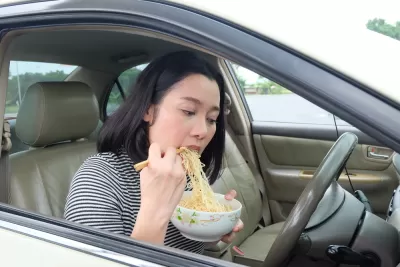A columnist explores how to create an environment that encourages focused, safe driving.

Want to reduce distracted driving? Think outside the textalyzer, researchers say.
Scott Sturgis, auto columnist for The Philadelphia Inquirer, spoke to traffic safety experts about what takes drivers' focus off the road—and found that it goes far beyond phone use. Car design and the built environment can create—or help prevent—disruptions to attention.
Of course, individuals aren't off the hook for how they drive; "personal responsibility" is on Sturgis's list of solutions. To address it, national agencies are working on campaigns to influence social norms and taboos.
But environmental factors also play a role, according to Sturgis's research. Here are other things to consider in attempts to reduce distracted driving.
- Engaging roadway design: A clear example is the use of roundabouts, which require drivers to stay alert for other cars without being stopped at a traffic signal.
- Intuitive vehicle design: Cars themselves can create distractions for the drivers in them. This applies to safety controls, like automatic braking and lane-departure warnings, as much as it does to stereo and A/C systems.
- App design: "There's real potential to effect change…on the mobile side," Sturgis writes. Some smartphone apps are seeking to gamify good driving—turning phoneless driving into a competition. Others are studying ways to provide real-time feedback on risky road behavior.
FULL STORY: Drivers are distracted by more than cellphones. Here's what can help them focus

Alabama: Trump Terminates Settlements for Black Communities Harmed By Raw Sewage
Trump deemed the landmark civil rights agreement “illegal DEI and environmental justice policy.”

Planetizen Federal Action Tracker
A weekly monitor of how Trump’s orders and actions are impacting planners and planning in America.

The 120 Year Old Tiny Home Villages That Sheltered San Francisco’s Earthquake Refugees
More than a century ago, San Francisco mobilized to house thousands of residents displaced by the 1906 earthquake. Could their strategy offer a model for the present?

Indy Neighborhood Group Builds Temporary Multi-Use Path
Community members, aided in part by funding from the city, repurposed a vehicle lane to create a protected bike and pedestrian path for the summer season.

Congestion Pricing Drops Holland Tunnel Delays by 65 Percent
New York City’s contentious tolling program has yielded improved traffic and roughly $100 million in revenue for the MTA.

In Both Crashes and Crime, Public Transportation is Far Safer than Driving
Contrary to popular assumptions, public transportation has far lower crash and crime rates than automobile travel. For safer communities, improve and encourage transit travel.
Urban Design for Planners 1: Software Tools
This six-course series explores essential urban design concepts using open source software and equips planners with the tools they need to participate fully in the urban design process.
Planning for Universal Design
Learn the tools for implementing Universal Design in planning regulations.
Clanton & Associates, Inc.
Jessamine County Fiscal Court
Institute for Housing and Urban Development Studies (IHS)
City of Grandview
Harvard GSD Executive Education
Toledo-Lucas County Plan Commissions
Salt Lake City
NYU Wagner Graduate School of Public Service


























